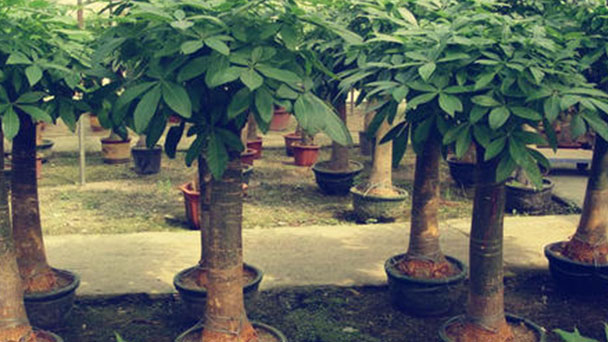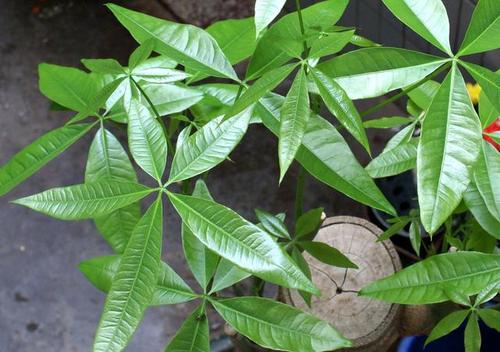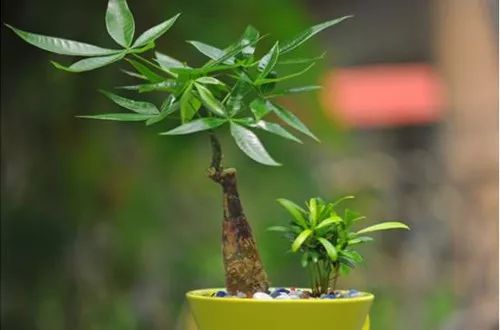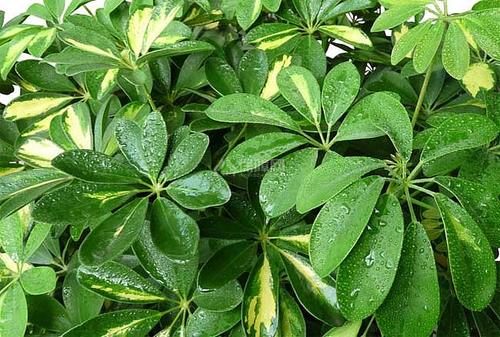Guiana Chestnut Care for Leaf Spots & Shoots Wilting
Written by Maggie
Dec 16 2021

How to care for Guiana Chestnut having spot
In the growing process of Guiana Chestnut, once the leaves have spots. it should be handled in a timely manner. If the pest damage first disinfection treatment before spraying carbamazepine solution. If watering too much, we should keep the basin soil moist. If fertilizing too much, we had better fertilize regularly. If the soil is not appropriate, replace the soil on the basin.

Guiana Chestnut is one of the best trees for pots
1. Disease prevention
What should we do if there are any longer patches over the guiana chestnut leaves? Generally speaking, the first thing we think of is the damage caused by diseases and insects. Because Guiana Chestnut likes growing in the high temperature environment. At this time, it is also a high incidence of some diseases and insect pests, especially leaf blight appeared more, which is also the most harmful one of the diseases.
When Guiana Chestnut leaf blight occurs, the leaves will initially have some small spots, which will gradually expand into irregular patches and infect other parts of the plant, causing the leaves to turn yellow and wither and die. It is best to cut off the dead leaves and rotten branches on the plant, with a small amount of potassium permanganate solution for disinfection, and then spray an appropriate amount of carbendazim solution, strengthening the air circulation.
2. Water properly
Although Guiana Chestnut likes growing in a warm and moist environment, if watered too much, the roots will rot, the leaves will not be able to photosynthesize properly, and the lack of nutrients will cause the spots to turn yellow. It is best to keep the basin moist soil. When the weather is dry, you can often spray water to the leaves.
3. Increase light
Guiana Chestnut is a kind of positive plant that likes to thrive in the sunny environment. If the light is too little, the root of the plant can't complete the metabolism naturally, and the nutrients sent to the leaves will be greatly reduced, which will lead to the leaves appearing spots and slowly falling off. It is better to keep the light for 6 hours every day.
Read More:
How to Care for Guiana Chestnut Leaf Tip Burnt & Trunk Root
How to Take Care of Guiana Chestnut Leaves Falling & Wilting
4. Reduce fertilization
Guiana Chestnut should be fertilized regularly during the growing process. If the amount of fertilizer is too much or too much, it will cause root burning phenomenon. As a result, the leaves of the plants will become flecked with malnutrition and will wither slowly. It is better to reduce fertilization, and apply compound fertilizer solution every 2 weeks after leaf improvement.
5. Soil replacement treatment
Because Guiana Chestnut likes growing in the deep sandy soil with good drainage. If the soil permeability is not good, root rot will occur, resulting in leaf spots yellow. It is best to replace the soil on the basin, the root on the rotten root cut off, and then use a small amount of potassium high-malate solution for disinfection, in the new soil to add a small amount of small stones again on the basin is best.
Read More: How to Care for Guiana Chestnut Root Rot or Leaf Yellowing

How to care for Guiana Chestnut new shoots wilting and turning black
Guiana Chestnut (although not flowering, but it has a high ornamental value), a lot of friends and flowers have farmed it used to decorate the home, but don't know why Guiana Chestnut buds wilting and turning black. The first thing you need to find new bud blight is a nigrescent reason, generally may be improper watering, fertilizing too strong, the environment temperature, sunlight, too much.
1. Watering for Guiana Chestnut
Guiana Chestnut do not need too much water, otherwise it will lead to pot waterlogging, cause root festering, affect the growth of Guiana Chestnut very much, and may also make the soil dried up, otherwise it will make the Guiana Chestnut lack of water, causing the Guiana Chestnut new shoots withered black. So watering must be careful.
Solution: If the Guiana Chestnut wither buds were black, we need to give it new soil immediately, and then water to master the correct method. During the spring and autumn in general, it can be watered once every 7 to 10 days. In the summer, it can be watered once every 3 days. It needs to be watered once a month in the winter, so as to better planting Guiana Chestnut.
2. Fertilization for Guiana Chestnut
Normally when growing Guiana Chestnut, we must pay attention to fertilize it. If there is not enough nutrient, it will make the leaves lose color, affecting the ornamental value of Guiana Chestnut. But do not give it too much fertilizer, otherwise it will cause Guiana Chestnut branches yellow, the new buds wither black, and finally Guiana Chestnut dies.
Solution: If it is caused by too much fertilizer, place it in the sun, or change the soil directly. Master the correct method of fertilization in the spring and autumn period and the two seasons can be 7 ~ 10 days a compound fertilizer. In summer, apply rotten cake fertilizer every half a month. In winter, it doesn’t need fertilization.
Read More: How to Care for Guiana Chestnut Leaves Saggy or No Buds
3. Sunlight for Guiana Chestnut
Guiana Chestnut needs sunshine in the growth, which can help Guiana Chestnut absorb nutrients, make it grow better, and has more ornamental value. If placed in the shade, the blade will lose colour, affect vision. If placed in the bright sunlight breeding, it can make leaf burns, black buds will wither.
Solution: If it is because the sun is too strong to cause the new buds to wither black, we need to move it to shade cultivation, waiting for the gradual recovery of leaves, then normal cultivation. Generally in spring and autumn three seasons it can be placed in the sun cultivation throughout the day. But in the summer it needs shade, in order to make the Guiana Chestnut growth better.
Read More: How to Take Care of the Guiana Chestnut Plant in Summer & Winter
4. Ambient temperature
Guiana Chestnut is suitable for growing in a 20 ~ 25 ℃ environment. If the temperature is below 15 ℃, it can make the Guiana Chestnut stop growing, and bring bad effects to the Guiana Chestnut. If it is below 10 ℃, it will cause the Guiana Chestnut frozen root, affect the Guiana Chestnut, absorb nutrients, unable to normal grow, and finally leads to sprout withered black, even cause Guiana Chestnut wilt die.
Solution: Guiana Chestnut is particularly high to the environment temperature. If the temperature is too low because the new buds fade and black, we need to immediately move Guiana Chestnut to the room, and then use the air conditioner, heater and other heating supplies. The growing environment temperature will be controlled in 16 ~ 18℃, which can help Guiana Chestnut safe winter, and help it grow better.

Read More:
- Guiana Chestnut Profile: Plant Info & Complete Care Guide
- How to Propagate Guiana Chestnut (from Seeds & Cuttings)
- How to Care for Guiana Chestnut Frostbite & Excessive Growth
- 3 Ways to Propagate Guiana Chestnut
- How to Care for Guiana Chestnut Frizzy & Growing too High
- Guiana Chestnut Leaves Slime & Drooping Causes & Care Solutions
Latest Updated
- Benefits of Bugleweed - 7 Science-backed Health Benefits
- Bugleweed Dangers & Side Effects - Is It Poisonous?
- How to Plant Evergreen Trees - What You Should Know
- When to Plant Evergreens - Grow Guide for Evergreen Trees
- 12 Wonderful Evergreen Shrubs for Your Garden
- 12 Popular Evergreen Plants with Pictures for Beginners
- When And How To Prune A Lilac Bush Like a Pro
- How to Grow & Care for Lilac Vine (Hardenbergia Violacea)
- Japanese Lilac Tree (Syringa Reticulata) Care & Propagation Guide
- Shumard Oak Pros and Cons - What to Know
Popular Articles
- Winter maintenance of Antirrhinum Majus
- How to Grow Terminalia Mantaly Tree
- How to Grow and Care for Crossostephium Chinense
- How to grow Antirrhinum Majus in spring
- Peristeria Elata (Dove Orchid) Profile: Info & Care Guide
- Underwatered Snake Plant (Sansevieria Trifasciata) - Signs And How To Fix
- How to Care for Brazilian Jasmine Plant (Mandevilla Sanderi)
- How to Grow & Care for Graptopetalum Purple Delight in Summer
- Rosa Chinensis (China Rose): Plant Growing & Care Tips
- How to Care for Baby Sun Rose (Aptenia Cordifolia)